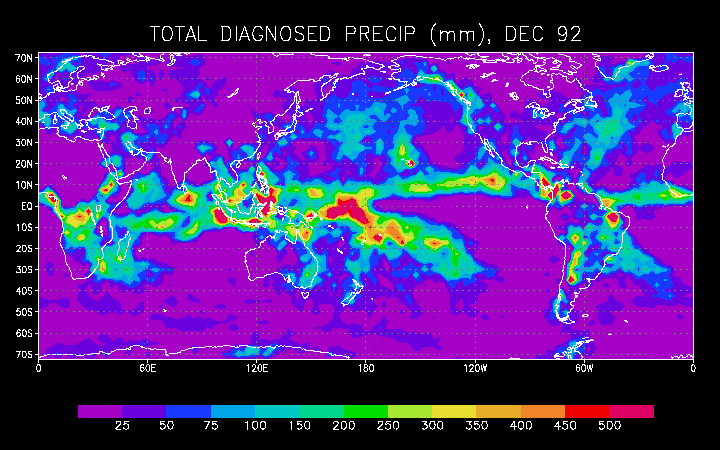TOGA/COARE: Tropical Ocean Global Atmospheres/Coupled Ocean Atmosphere Response Experiment (TOGA/COARE)
TOGA/COARE (Tropical Ocean Global Atmospheres/Coupled Ocean Atmosphere Response Experiment) was an international research program investigating the scientific phenomena associated with the interaction between the atmosphere and the ocean in the warm pool region of the western Pacific. The field experiment phase of the program took place from November, 1992 through February, 1993 and involved the deployment of oceanographic ships and buoys, several ship and land based Doppler radars, multiple low and high level aircraft equipped with Doppler radar and other airborne sensors, as well as a variety of surface based instruments for in situ observations.
From: The NASA TOGA/COARE Data Archive
Investigators
- Dr. John A. Young Department of Atmospheric and Oceanic Sciences (AOS)
- Dr. Donald Wylie Space Science and Engineering Center (SSEC)
Related Websites
Publications
-
Anderson, S. P.; Bradley, E. F.; Chen, S.; Esbensen, S. K.; Lukas, R. B.; Meechl, G. A.; Rothstein, L. M.; Rutledge, S. A., and Young, J. A. The ‘Gaps Group’ Report: The challenges that remain to complete the goals of COARE. COARE-98: Proceedings of a Conference on the TOGA Coupled Ocean-Atmosphere Response Experiment (COARE), Boulder, CO, 7-14 July 1998. Geneva, World Meteorological Organization (WMO), World Climate Research Programme (WCRP), 1999, pp142-147. Reprint #2570.
-
Dengel, Russell C. and Velden, Christopher S. Utilization of McIDAS in support of the TOGA COARE field program. International Conference on Interactive Information and Processing Systems for Meteorology, Oceanography, and Hydrology, 11th, Dallas, TX, 15-20 January 1995 (preprints). Boston, MA, American Meteorological Society, 1995, pp327-330. Reprint #1767.
-
Friedman, Michael A. and Ackerman, Steven A. Deriving statistically based radiative heating profiles and energy budgets in the tropical Western Pacific. COARE-98: Proceedings of a Conference on the TOGA Coupled Ocean-Atmosphere Response Experiment (COARE), Boulder, CO, 7-14 July 1998. Geneva, World Meteorological Organization (WMO), World Climate Research Programme (WCRP), 1999, pp237-238. Reprint #2572.
-
Friedman, Michael A. Cloud classification and determination of cloud properties in the tropical Western Pacific from satellite imagery. COARE-98: Proceedings of a Conference on the TOGA Coupled Ocean-Atmosphere Response Experiment (COARE), Boulder, CO, 7-14 July 1998. Geneva, World Meteorological Organization (WMO), World Climate Research Programme (WCRP), 1999, pp225-226. Reprint #2571.
-
Hagan, Denise and Nalli, Nick. Sea surface temperature retrievals from multiple bandpass radiances in the 10 to 12 micron region. COARE-98: Proceedings of a Conference on the TOGA Coupled Ocean-Atmosphere Response Experiment (COARE), Boulder, CO, 7-14 July 1998. Geneva, World Meteorological Organization (WMO), World Climate Research Programme (WCRP), 1999, pp283-284. Reprint #2581.
-
Hinton, Barry B. Satellite images, satellite sounder data, forecast model grids and SST composites archived by SSEC for TOGA/COARE (ATM-9209064; NASA NAG1-553; USAF F19628-91-J-0007). Madison, WI, University of Wisconsin-Madison, Space Science and Engineering Center, 1993. Various paging. See also Video Tapes #57 and #58. UW SSEC Publication No.93.07.H1.
-
Kung, Terence. Surface forcing and clouds in the atmospheric boundary layer during TOGA COARE. Madison, WI, University of Wisconsin-Madison, Department of Atmospheric and Oceanic Sciences, 1997. iii, 28p. Bachelor of Science Senior Thesis. UW MET Publication No.97.03.K1.
-
Lazzara, Matthew A. Tropical atmospheric predictability during TOGA COARE. Madison, WI, University of Wisconsin-Madison, Department of Atmospheric and Oceanic Sciences, 1997. iv, 120p. M.S. thesis. UW MET Publication No.97.06.L1.
-
Marzano, F. S.; Turk, J.; Dietrich, S.; Mugnai, A.; Panegrossi, G.; Pierdicca, N., and Smith, E. A. Microwave multisensor rainfall retrieval applied to TOGA-COARE observations. IGARSS ’95: 1995 International Geoscience and Remote Sensing Symposium, Quantitative Remote Sensing for Science and Applications, Firenze, Italy, 10-14 July 1995. Proceedings, v.3. Piscataway, NJ, Institute of Electrical and Electronic Engineers, Inc. (IEEE), 1995, pp1898-1897. Reprint #2925.
-
Scientific plan for the TOGA Coupled Ocean-Atmosphere Response Experiment: Advance copy for the participants of Inter-governmental TOGA Board, Third Session, Geneva, 9-12 January 1990. Geneva, World Meteorological Organization (WMO), World Climate Research Programme (WCRP), Tropical Ocean and Global Atmosphere Programme (TOGA), 1990. Various paging. QC/993.5/T5631/1985.
-
Velden, Christopher S. and Young, John A. Satellite observations during TOGA COARE: Large-scale descriptive overview. Monthly Weather Review v. 122, no.11, 1994, pp2426-2441.
-
Velden, Christopher S. Satellite observations during TOGA COARE. Conference on Satellite Meteorology and Oceanography, 7th, Monterey, CA, 6-10 June 1994 (preprints). Boston, MA, American Meteorological Society, 1994, pp47-50. Reprint #1823.
-
Young, John A. and Lazzara, Matthew. Predictability of large-scale convective systems during COARE: A GCM and satellite survey. COARE-98: Proceedings of a Conference on the TOGA Coupled Ocean-Atmosphere Response Experiment (COARE), Boulder, CO, 7-14 July 1998. Geneva, World Meteorological Organization (WMO), World Climate Research Programme (WCRP), 1999, pp331-332. Reprint #2573.
-
Young, John A. Problems of surface wind assimilation for the tropical Pacific. Air-sea Interaction in Tropical Western Pacific: Proceedings of US-PRC International TOGA Symposium 1988 Beijing. Beijing, China, China Ocean Press, 1990, pp3-13. Reprint #1789.
-
Young, John A.; Kung, Terence, and Li, Jui-Lin F. Turbulence regimes in the atmospheric boundary layer during COARE: Observed surface forcing and implied shallow cloud effects. COARE-98: Proceedings of a Conference on the TOGA Coupled Ocean-Atmosphere Response Experiment (COARE), Boulder, CO, 7-14 July 1998. Geneva, World Meteorological Organization (WMO), World Climate Research Programme (WCRP), 1999, pp345-356. Reprint #2574.


